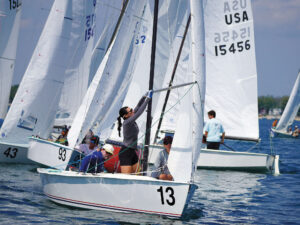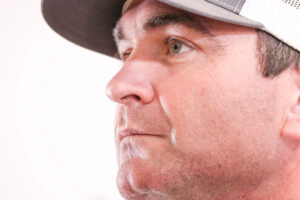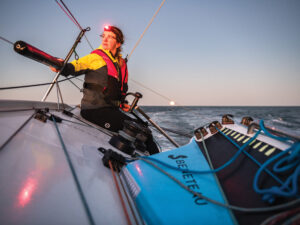A few weeks ago, I was lucky enough to attend a small community event in Les Sables-d’Olonne, a resort town on France’s West Coast that hosts the start and finish of the Vendee Globe. There, Luc Van Den Heede, who placed third in the first Vendée Globe in 1989 and then second in 1993, and up-and-comer Arnaud Boissières, who placed seventh in the last race, were on hand to speak to a crowd of just a hundred or so at the local community center about their adventures.
Long-distance sailors in France can enjoy a rock star-like status, and setting up just a phone interview often requires convincing PR reps or publicists that it’s worth their sponsors’ time to get their yachtsman on the phone. It was thus a refreshing change of pace to attend such a laid-back event where two of France’s great sailors were so accessible.

**Valérie Reynaud
**_Luc Van Den Heede and Arnaud Boissières discuss their Vendée Globe adventures with local crowds in Les Sables-d’Olonne.
_
Community members on hand that night were eager to hear about the racers’ experiences sailing around the world. During the Q&A session, they asked about what life on board was like, jibing in 20-feet waves in the middle of the Indian Ocean, how much sleep they got, how they ate and washed, and a host of other basic yet hardly naïve questions.
After their talk on stage, both yachtsmen were kind enough to share with me their thoughts about the direction the Vendée Globe has taken over the past two decades. They gave me a better understanding of an issue that keeps creeping up in conversations I have around France: the insane costs required to compete in the fabled race.
If there’s one truism about how the Vendée Globe has evolved during the past two decades, it’s that any sailor who dares to pursue his or her dream of sailing alone around the world in the race needs a very large sum of money to be a true contender. Dodging icebergs and low pressure fronts in the terrible forties, dealing with breakages thousands of miles from help, or facing anything else Mother Nature might unleash on you in the middle of nowhere will cost well over a million dollars if you want to stand a chance of finishing near the top—that is, if you manage to finish at all, considering that no more than 15 sailors ever completed the race in one year. How’s this for comparison? In the first Vendée Globes, Van Den Heede managed to take a leave as a schoolteacher and place in the top-three with a budget of less than $300,000 in today’s dollars.

**Valérie Reynaud
**Arnaud Boissières is one of the favorites for the next Vendée Globe race in 2012-2013.
Indeed, the days are long over when an amateur sailor has much hope of taking sabbatical from work, finding the necessary money, and placing in the top-five finishers, Van Den Heede said. You either must be independently wealthy or an IMOCA-class racing professional that can convince a sponsor to pay millions for the right IMOCA-class boat and engineering teams that are needed to place among the top-five finishers. “Paying two million euros to come in 12th doesn’t hold much appeal for a sponsor,” Van Den Heede said.
Amateurs without much money can still do the race, but they’ll definitely bring up the rear, Van Den Heede said, adding that, for 100,000 Euro, he’d be glad to sell the boat with which he placed second in 1993—but even the best sailor is likely to come in dead last with it. And if you survive to place tenth, don’t expect anybody to show up who might cheer your arrival besides friends or relatives, he said.
Boissières offered a more the glass-is-half-full assessment. While he’s one of the favorites to win at or near the top of the next Vendée Globe in 2012-2013 on the Akena, Boissières also said the great race is not all about just winning, either. In fact, he emphasized how adventurers with a limited budget can sail the course with other Vendée Globe greats.
The race organizers have a strict set of requirements you must meet to enter the race—not just anybody can jump on a boat and put their life in danger like they did back in the 1968 Golden Globe. Besides having an IMOCA-class boat, there’s a 20,000 Euro deposit. “The Vendée Globe is still open to those who are not necessarily millionaires,” Boissières said.
And at the end of the day, it’s also about sailing and the extreme skills and knowhow that go with it. Even those with the fastest boats are by no means going to win, Boissières said.
“You sail alone for three months, so let’s just say you have to know how to handle the foresail,” Boissières said.
After speaking with Van Den Heede and Boissières, I began to wondering if the Vendée Globe might benefit from different classes, like the Route Du Rhum transatlantic race does. For those who want to go on the adventure of their lives, a class for different types of slower-and often older-boats could help even the playing field a bit. Do I dare dream of such a possibility?









